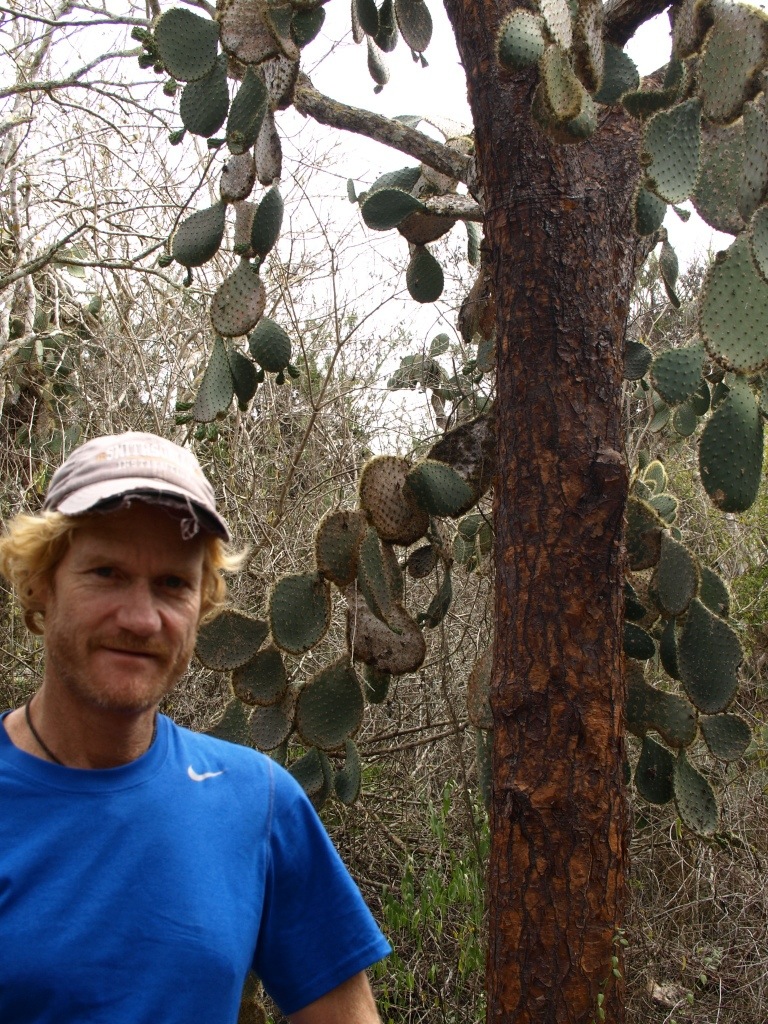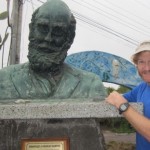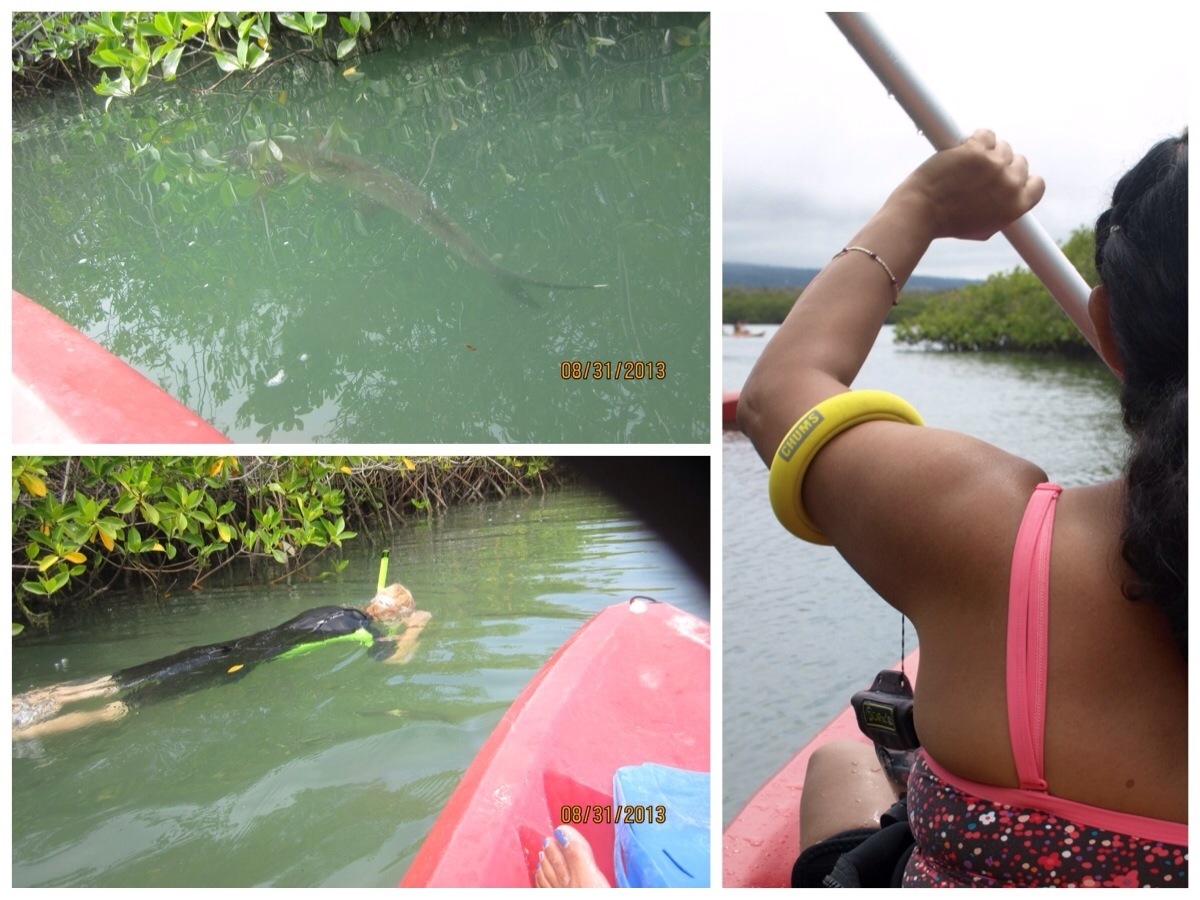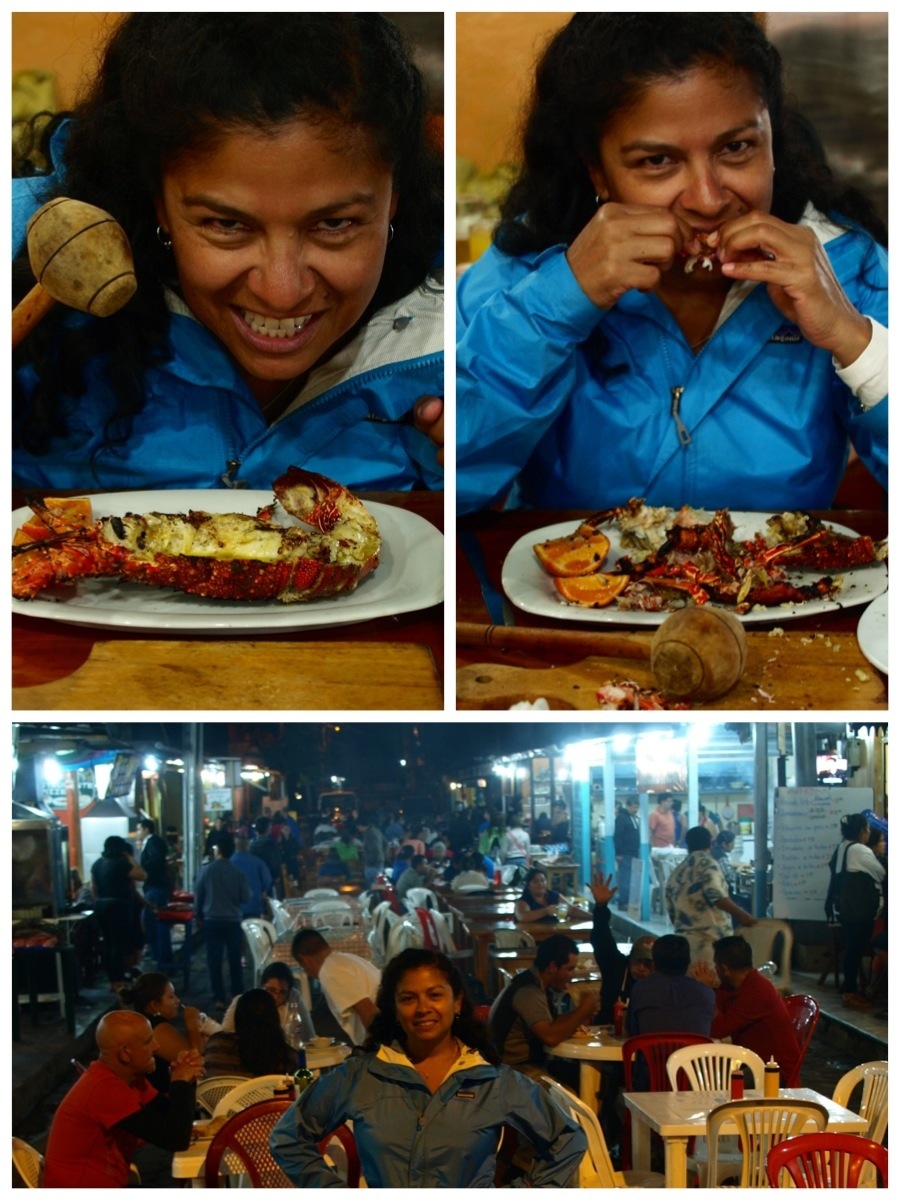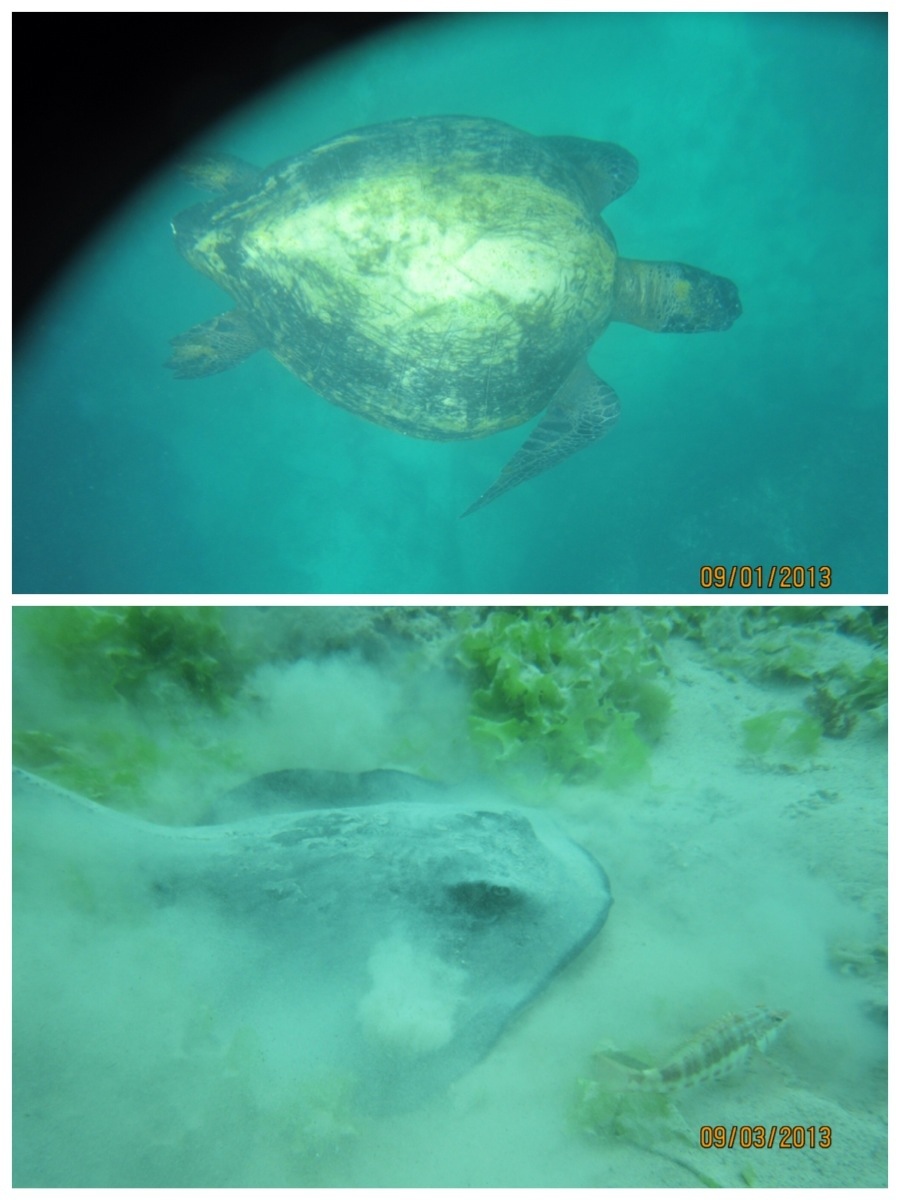(Galápagos Islands, Ecuador – 4 September, 2013) One of the mostly highly prized destinations in all the world is the Galápagos Islands….and we were there. Of all the places we plan to travel this year Galápagos sat high on our most-treasured places list. Now we’ve been there and done that. So, in addition to sharing some stories of what we saw and what we did, I will give you the unvarnished truth about Galápagos- the good, the bad, and the snuggly.
“Not What I Pictured”
We landed on Baltra Island, just one of the 18 islands of significant size that make up the Galápagos Islands (officially named the Archipelago of Colon.) Additionally, there are hundreds (perhaps thousands) of tiny islets and rock outcroppings that make up the entire chain of islands. Most people coming to Galápagos land on Baltra Island because it sits close to the middle of all the major islands and is the nearest runway to where the most people are– the city of Puerta Ayora on the island of Santa Cruz.
You may have a notion that very few people actually live on the Galápagos Islands…like maybe it’s just the Park Rangers, a few volunteers, plus a couple of research scientists. Not true. Puerta Ayora alone is a town of more than 20,000 people. They have schools and grocery stores and laundry mats and hospitals, etc. Thousands more live in little towns spread all over the islands, though no other concentration of people is nearly as large as Puerta Ayora.
The islands of Baltra (where we landed) and Santa Cruz (where we stayed) are almost one island; only a narrow strip of water separates the two. It’s close enough to swim, but better to take the ferry for $1 if you want to keep your luggage dry. Baltra, the airport, the ferry, that’s all happening on the north end of Santa Cruz. Puerta Ayora is all south side, bro. To traverse the island, all comers must either take the 1 hour bus ride or slightly faster taxi. (Personal/private cars are not allowed.) Walking the length of the island would surely be a rewarding experience, too, but that’s an all-day affair and probably not the best use of your time.
The highway from the ferry on the north side of Santa Cruz to Puerta Ayora on the south side cuts directly through the island’s middle. Climatologists would surely find the journey interesting because of how much the ambient changes when crossing from one end of the island to the other. The northern half is almost desert, not the Arizona (roadrunner and coyote) type, but very reminiscent of far west Texas. The entrance to Big Bend National Park on Galápagos? Yep! Now you’ve got it.
The highest point on Santa Cruz island is its center. Meaning, the bus ride took us directly up-and-over its raised middle. As we approached “the highlands” (around 1600 ft), we were leaving the desert climate behind; blue skies mixed to gray and the vegetation thickened. From there we practically rolled downhill all the way into Puerta Ayora where we stayed for 5 nights.
I’d seen enough pictures of the Galápagos Islands before coming here to know what to expect, but Jessica had not. I imagine her idea of Galapagos is typical– lush green forested islands surrounded by beautiful translucent turquoise waters. The gorgeous water part is spot on, but “lush green” it is generally not. Galápagos has two seasons, wet and dry, each lasting about half the year. Apparently, however much rain the islands get, it’s not enough to result in greenery typical of tropical islands. The Galápagos Islands are amazing and abundantly beautiful, just not necessarily in the way one might expect.
Here I am with a cactus tree. It is a cactus, but grows up tall like a tree. Check out its unusual bark.
Darwin’s Wild Life
The Galápagos Islands are known the world over primarily for two (intertwining) reasons, the unique wildlife and the hugely important contribution the study of that wildlife made to the scientific community, with special regard to the biological origins of life. While in his early twenties, Charles Darwin spent just five weeks in the Galápagos Islands and only landed upon four of them. But what he observed on those islands in that short period of time contributed to him solving one of the greatest puzzles of science- how and why new species are created.
In case you don’t know the story, here’s the gist. Since the islands were so remote and relatively young geologically, Darwin’s first question to ponder was how did the animals get there? Regarding only the finches, (since they were perhaps the biggest players in Darwin’s story), it was assumed that a few of them must have somehow arrived to one of the Galapagos Islands from the mainland. After all, they were similar enough to the mainland finches. Perhaps they got caught up in a storm or wound up stranded on some driftwood that floated over from the mainland. Who knows? The point is that those first few early birds reproduced successfully enough to eventually populate their island.
From there a few adventuresome birds wound up on a second island and populated it. And then to a third island, and then a fourth, etc. The key was that the finches on each island were slightly different- especially their beaks. And they were each different in ways that better suited them for survival on their particular island. So, if they were all descendants from the first arrivals, how did they become differentiated? Darwin’s ground-breaking answer was: Natural selection.
Did Jessica and I see these finches? You got that right! They are immanently cute and very friendly, especially when there was food to be had.
He comes close….closer….oops, too close! …Ah what the heck.
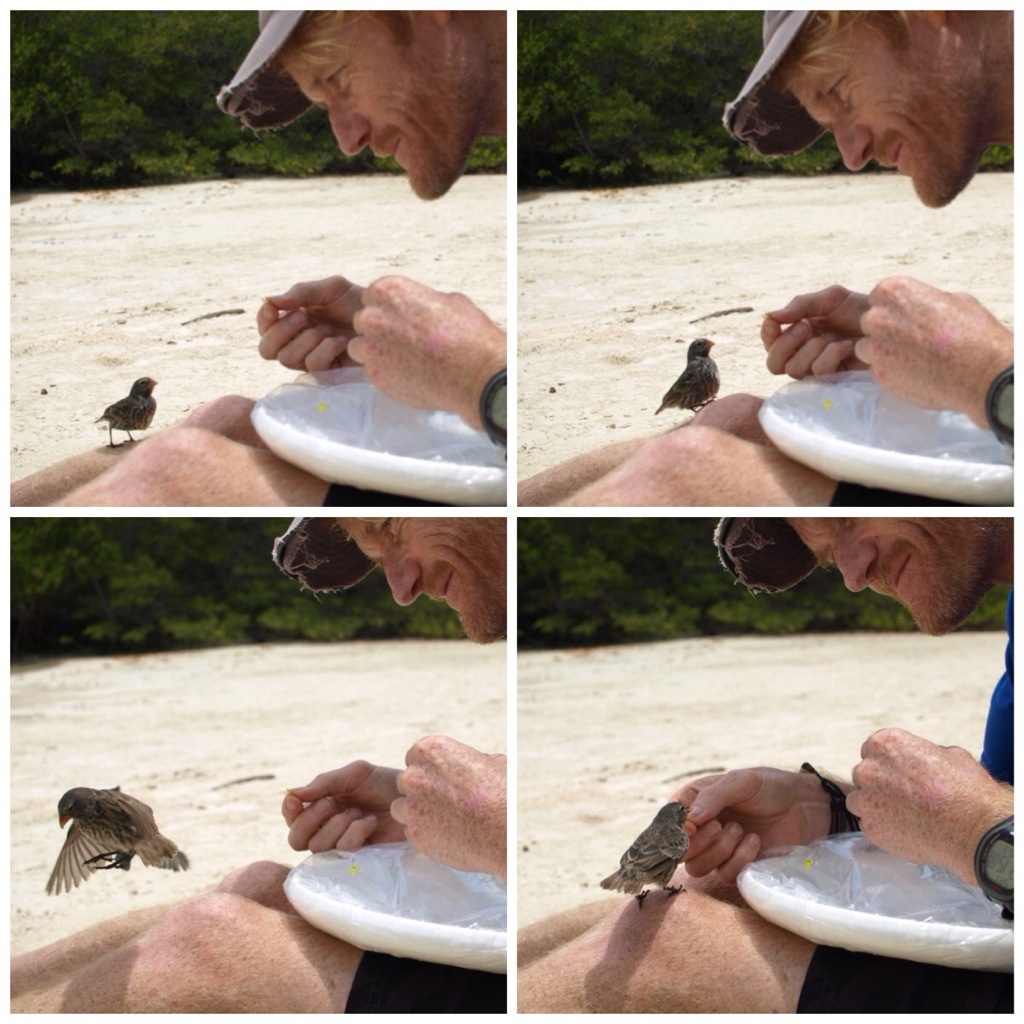
Tortuga Bay
One of our first explorations of Santa Cruz Island was a memorable trek to Tortuga Bay. Just a few blocks away from our hostel began a nicely constructed stone path we strolled down for about 45 minutes before it delivered us to a beautiful powder-sand beach. Another 15 minutes of walking the length of the beach lead us through a colony of marine iguanas to our Tortuga Bay destination.
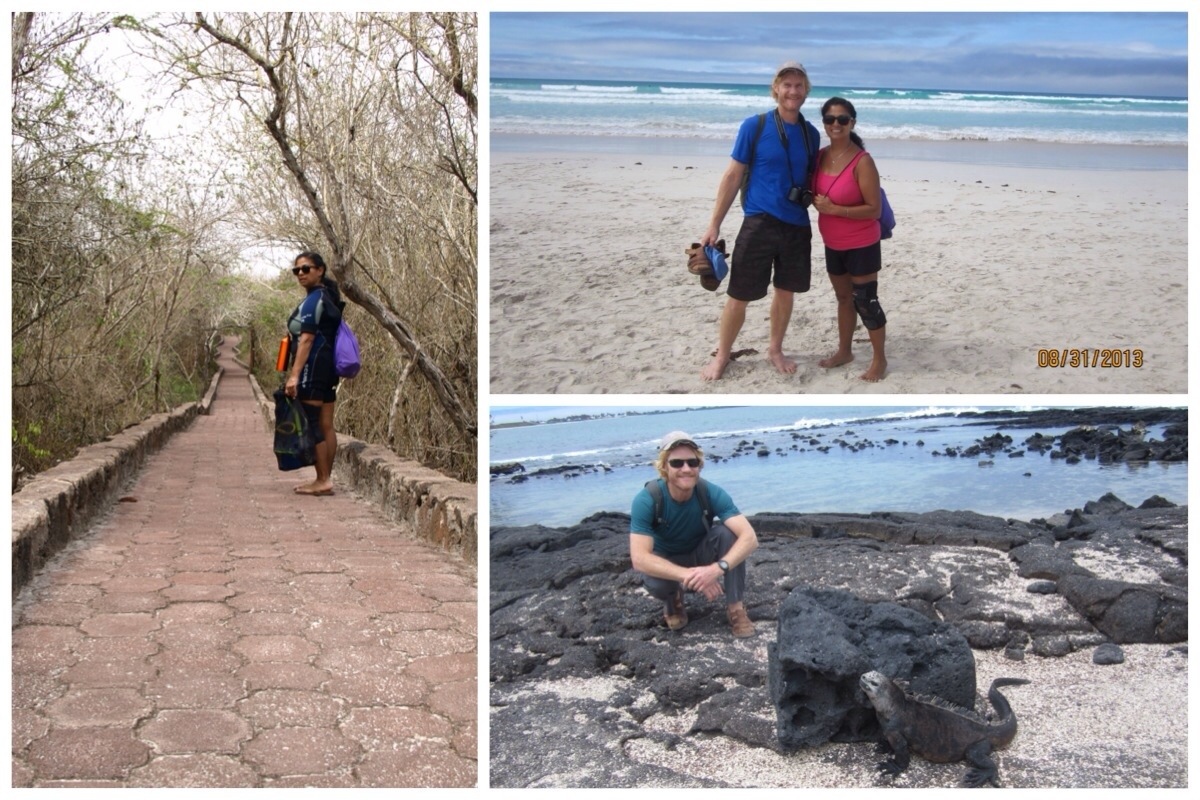
Once there we rented a kayak and began exploring the waters by paddle. We’d brought snorkeling gear with us, too, if we chose to look for life underwater. The small bay was protected by mangroves on two sides and a beach on the near end. The side that opened to the ocean was guarded by volcanic rocks leaving the waters of Tortuga Bay forever calm. We were told we might find white tip sharks if we hugged the line of mangroves on the left so we paddled there first. It didn’t take long before Jessica spotted our first shark of the day. About four feet long and sporting a little white color on its dorsal fin, this happy hunter slithered by us like he hadn’t a care. We gave chase in our kayak trying to capture a photo, but this shark wasn’t cooperating. Moments later he was lost to the glare shining on top the water.
Not to worry, apparently we were paddling on the white-tipped shark highway because it wasn’t long before we spotted another. Soon after, a third. None posed for a photo-op, but we managed at least one decent snap.
Eager to try out the snorkeling, I dipped slowly from the kayak into the chilly, “shark-infested” waters. Saw some fish, but no sharks. Once back in the boat, we paddled towards the other side of the bay where they said turtles could be found. Sure enough, Jessica spotted a sea turtle at some distance just coming up to the surface for a breather. We paddled over to snatch a photo, but he submerged himself shyly just as Jessica was lifting the camera. Hey, it ain’t easy to paddle a kayak and operate a camera at the same time. You try it.
More turtle searching lead us to spot some sea birds on the far bank. We paddled closer to find a pelican and several slightly smaller birds with pretty blue feet. We’d found the famous blue-footed boobies! We kayaked closer and fumbled with our cameras. This time, however, there was no need to rush. That’s one thing about much of the wildlife on Galápagos, they don’t have a natural fear of man. We floated right up upon them and they scarcely batted an eye.
Los Kioskos
During our very first bus ride on the island (the one from the ferry to Puerta Ayora), I was last to board and wound up seated next to the bus driver. I learned he was a born and raised 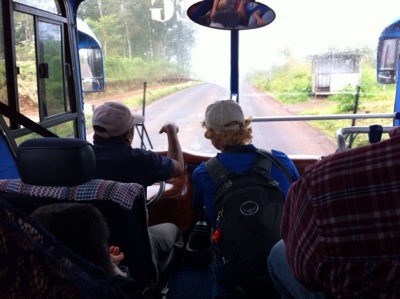 on Santa Cruz Island so I took advantage of the moment and asked him where he likes to eat in Puerta Ayora. His smiling response, “En mi casa.” Say what?! Okay, turns out our bus driver was also a comedian. After giving him the laugh he deserved, I pressed him for a real answer and he offered, “Los Kioskos.”
on Santa Cruz Island so I took advantage of the moment and asked him where he likes to eat in Puerta Ayora. His smiling response, “En mi casa.” Say what?! Okay, turns out our bus driver was also a comedian. After giving him the laugh he deserved, I pressed him for a real answer and he offered, “Los Kioskos.”
Was this the name of a restaurant? A street? Turns out neither. It was simply a term the locals use for a section of a street that food vendors crowd with tables and chairs each evening around dinner time. Hungry diners soon fill the seats. Since Los Kioskos was only a block away from our hostel (and cheap and good), we ate there three or four times including one of our splurge-nights when we decided to share a fresh-caught lobster. It was dee-ee-licious!
Day Trippers
We booked all five of our nights in Puerta Ayora on Santa Cruz Island with the plan of going on day-trips from there. It’s a great hub, but admittedly committing to 5 nights in one location didn’t give us the flexibility to stay over on another island if that is what we wanted to do. It all worked out, but if we had it to do over again, we might have paid for just one or two nights at a time.
The two excursions we chose were a land and sea guided tour of Santa Cruz Island, and a guided tour of Isabella Island which lies 2 1/2 hours to the west of Santa Cruz by boat. On these tours we got up-close and personal with the famous Galápagos giant tortoises, and oodles of sea lions we were warned not to touch, though the urge to scratch their heads like you would a dog was extremely strong in me. Time for snorkeling was included in both our tours giving us additional chances to snap the coveted sea turtle pic we’d missed earlier. We also followed a cool manta ray for a while and got him to strike a pose.
The tours took us to several cool spots we might never have seen on our own. The Muro de Lagrimas (Wall of Tears), for example. It’s a designated international historic site on the island of Isabella, which was used as a penal colony in the late 1940’s. (Ecuador’s version of Alcatraz.) One of the most interesting facts about the prison was that it had no walls. Prisoners could run around the island all they wanted. However, they could never venture too far because the island has no natural sources of drinking water. Their very lives depended on the desalinated water dispensed by the prison guards.
A second charming story we were told about the prison involved a brutal warden that decided his prisoners needed to build a wall around their compound. He demanded the construction of the wall be such that it could not be scaled without triggering an avalanche of the heavy lava rocks from which it was made. Its dimensions were 22 feet high and 22 feet wide at the base. Only a relatively small portion of the wall was ever finished. Nevertheless, many prisoners died from injury or exhaustion (or were outright killed by the guards) during its construction.
To me the wall looked like it would be easy to climb, but our guide told us that a couple of years ago two college-aged visitors tried to scale it for a photo-op. One ended up with a broken leg when the wall did what it was designed to do….crumble on top of would-be escapees (and knuckleheaded tourists).
In, on, and all around the boat dock on Isabella Island were dozens of sea lions. They lazed on top of the streets and sidewalks like stray dogs. Again, so snugly cute, but our guide was clear that we not touch them. (But… “They’re so fluffy!”) Among the not-so-fluffy on Isabella were the largest sub-species of marine iguana; yellow-ish fellows with Freddie Kruger claws. Some say they see a wry smile in each of those little iguana faces, but I have trouble finding it.
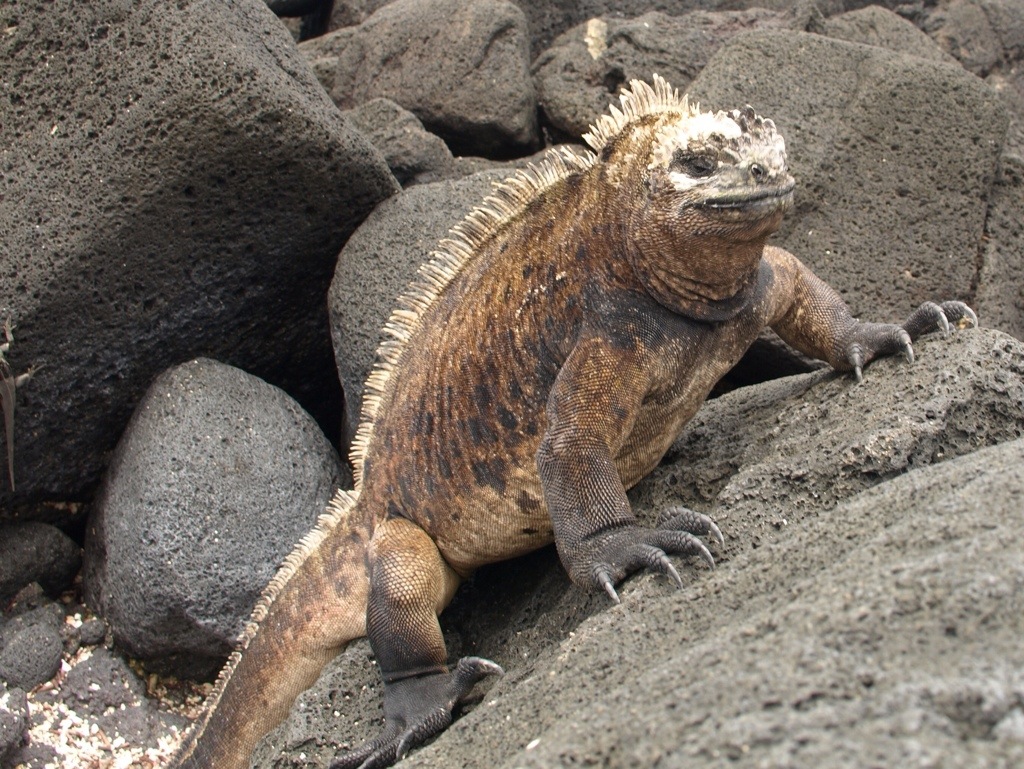
Two Views of Galapagos
Most people that visit the Galápagos Islands do so very differently then we did. To stay within our modest travel budget, we spent our nights in a hostel on one of the islands and sought out day-trips from there. The more expensive alternative would have been to choose a cruise package. Cruises can be as short as 4 days/3 nights, or as long as two weeks. When you choose to cruise, you sleep on the boat each night and eat most of your meals there, too. Travel between the islands is done overnight while you sleep (or party) so that each morning you wake up parked smartly in front a new island.
Cruise ship accommodations will range from budget to luxury as will the size of your boat- from smaller and more intimate to larger and more stable, all depending on your preference. Day-trips to the islands from the cruise ships are always lead by a knowledgable (and probably English-speaking) guide. The cost per person per night will start at around $150 and go up from there. Awfully pricey for us, but the advantages of seeing the Galápagos Islands in this way are considerable. You will probably see more of what you came to the islands to see by cruise ship than you could any other way.
However, by cruising you would miss many of the great experiences we had (even through gaining others). For example, I rented a bicycle one afternoon and paid a taxi driver $10 to take me (and the bike) to the highlands of Santa Cruz island. From there I visited two exotic looking craters called Los Gemelos (The Twins), saw roadside tortoises in their natural habitat, and hiked through a very cool half-mile long lava tunnel. I then stopped off at a the tiniest of tiendas for a Coke and to eat my lunch– a homemade tuna sandwich I’d packed for my trip. Afterwards, I rolled back down to Puerta Ayora and rejoined Jessica who had spent her day strolling through the shops and relaxing in a hammock. It was the kind of great day a cruise ship package couldn’t possibly include.
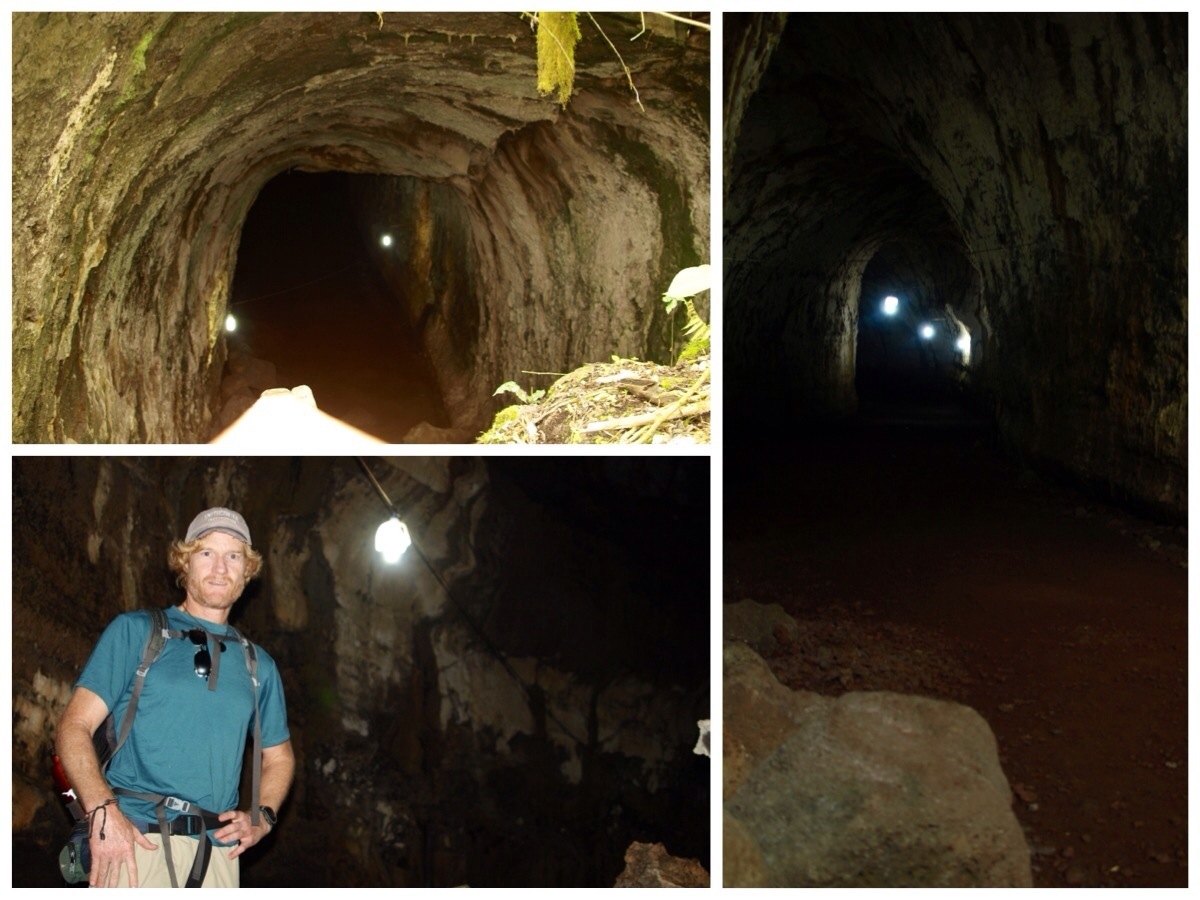
Sad to Leave, But Happy to Whale
Jessica and I both experienced a wave of sadness on the day we departed the islands. Who knows if we will ever go there again? We certainly would like to, but on a cruise ship next time… to get that second view of the islands we didn’t experience this time around.
After leaving Galápagos, we flew to the Ecuadorian city of Guayaquil where we caught a 4 1/2 hour bus ride to Puerto Lopez, our final destination in Ecuador. We were heading to this coastal fishing town with one goal in mind… to see some whales! The write-up for the hostel we stayed in said we might even see whales from our couch! We did not, but I have no doubt it’s been done before. The hostel was a little apartment and sure enough we could see a big swath of the sea right through the living room window, but I guess no whales were crossing when we were looking.
We had much better luck once we signed up for a whale-watching excursion. It’s hard to describe the level of excitement one experiences when seeing a whale swimming in the wild. It’s intensely thrilling so say the least; makes you want to take a deep breath and hold it…as if that will freeze the moment a little longer.
The first sighting was of two whales who swam together like a couple out for a stroll. At first they looked like massive black dolphins, their shiny smooth backs and dorsal fins rolling through the water’s surface. But when their massive tales rose high out of the water, they were exclusively and clearly whales; humpback whales, to be specific. One of them lifted his tale and then smacked it down four times in a row before diving out of sight. I think he wanted to make sure nobody missed taking his photo.
We heard our boat’s captain talking on his cell phone. He was checking with his other whale watching boat captain buddies to find out where we might find some more. Moments later we were skimming quickly over the high seas to another (I guess, not so randomly chosen) spot in the ocean. Ahoy, matey! Two more whales were soon spotted. This duo gave us even more of a show than the first couple. As they swam lazily through the surf, one lifted its huge 15 feet long pectoral fin into the air and smacked it down upon the water’s surface. Smack to the left! Then a smack to the right! The whale was practically rolling over onto its back as it splashed those big flippers around. It is called pec slapping. Experts think it’s done to dislodge barnacles and sea lice that will build up on the whale’s skin if they don’t smack it off periodically.
After the pec slapping, the whales momentarily disappeared. I then heard the boat’s driver say, “Mira. Va a saltar.” He was saying, Keep watching, he’s going to jump. Sure enough, one of the whales rocketed out of the water and crashed back down upon the waves in spectacular fashion. Seeing a whale breach the water like that is the pinnacle event for a whale watcher. It is what you hope to witness, and, if you’re lucky, take a picture of. But really, what are the chances? In our case, chances were excellent. Are we good, or what!? (By “we” I mean Jessica. She took the photo and video.)
Whale tale with music…
Our experiences in Galápagos and on the whale watch were priceless. Ecuador as a whole was a great country to visit, too. We are so glad we came. The downside is that now we know there are even more places in Ecuador we’d like to visit. Aaaargh! I guess we’ll have to come back to Ecuador some day. But next is a 30 hour bus ride to Lima, Peru.
Surprises await, I assure you.


